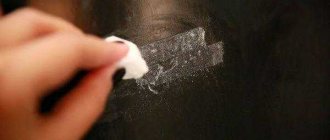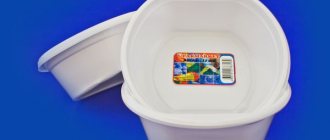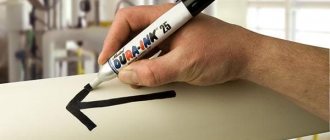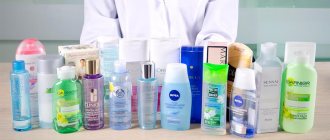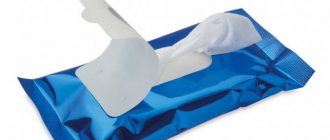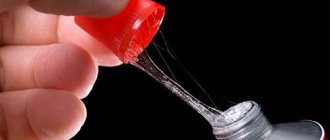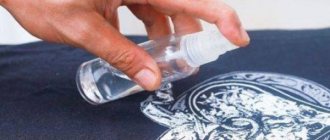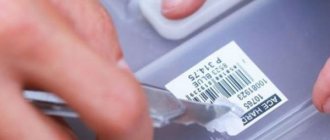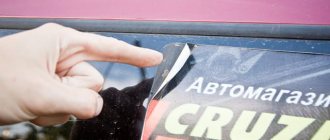Today you can hardly find a household appliance or other item that is sold in a store without stickers, sticky price tags and advertisements. In addition, there are special protective films. Beautiful, bright and modern! However, it is simply impossible to remove such delights from the surface of an object. Happened? Look at the place where it was glued. There you will definitely see a trace left from the adhesive base. Then you need to know what and how to properly remove stickers from different surfaces without damaging the item.
What means can you use to remove stickers?
The surface from which the sticker has just been removed needs urgent treatment. Otherwise, a large amount of dust will stick to it, and it will be much more difficult to clean this place. Each item is made from a specific material, which has its own structure and texture. Therefore, for any thing you need to use only certain substances and devices. The following substances can be used to clean different surfaces:
- (or any vegetable that has no color);
- Mayonnaise;
- Alcohol-containing substances;
- Ammonia;
- Esters of vegetable oils;
- Cleaning agents containing a lot of citrus fruits;
- Nail polish remover;
- Aviation gasoline, lighter fluid;
- Glass cleaner;
- Special spray for cleaning sticky components;
- Melamine sponge;
- A piece of foam rubber;
- Soft cloth;
- Any unnecessary plastic card;
- Iron;
- Blank sheets of paper.
How to remove sticky sticker residue?
There are several options for removing adhesive residue from stickers. The required option can be selected depending on the surface of the product.
Peeling off
We will use this method if the sticker is not firmly glued to the product. The main part of it is carefully removed, the remnants are rolled with dry fingers into small twists and removed from the surface. Try not to scratch the remaining substance with your nails to avoid damaging the product. If you are unable to get rid of the sticker this way, proceed to the options described below.
Vegetable oil
For this purpose, take any vegetable oil. Both regular sunflower and corn, olive or cotton are great. The method of using the product is simple:
- Dip a piece of soft cotton cloth into oil;
- Treat the sticker stain;
- Wait 10 minutes for the glue components to soak in the oil;
- Clean off any residue with a plastic card or the back (dull) side of a knife blade;
- Wipe the treated area with a cloth soaked in water and detergent.
This method is great for products coated with a layer of paint or varnished wooden surfaces. Instead of vegetable oil, you can use mayonnaise.
Essential oils
It is excellent to remove glue residues using. You can take burdock, sea buckthorn or, the result will be the same.
So, the sequence of actions is as follows:
- Apply ether to the sticker stain;
- Distribute it over the entire stained surface;
- Leave for 10 minutes;
- Using a soft cloth, roll up the remainder in a zigzag motion;
- Take a paper napkin and wipe the work area;
- Finally, spray the area with any glass cleaning liquid and wipe dry.
Before using these substances, be sure to test the underside of the product to ensure that the substances do not leave stains.
Citrus
Each citrus-based product contains granules. They help to corrode the remaining glue and easily remove it from the surface. It is better to use products in the form of gels or sprays.
- Apply the substance to the stain and leave for a few minutes;
- Wipe with a dry cloth or paper napkin;
- Wipe with water and a small amount of detergent;
- Apply polish (if necessary).
Alcohol (96%) medical
It's no secret that this substance has remarkable cleaning properties. The same applies to alcohol-containing substances - colognes, perfumes, vodka, deodorants.
- Take a sponge;
- Soak it in the selected substance;
- Wipe the surface.
Be sure to test the alcohol-containing substance on the back of the product. Alcohol may react with the finish of the product and leave stains.
Scotch
Using regular masking tape, you can quickly remove sticker residue from flat surfaces. This method works especially well in the case of fresh stains:
- Remove the sticker;
- Place a piece of masking tape with the adhesive surface on the remaining stain;
- Leave the “tail” of the tape in your hand so that you can grab it tightly;
- With a sharp upward movement, tear the tape off the surface;
- If necessary, repeat the process with a new piece of tape.
Remove any remaining glue using a damp cloth. Wipe with a dry cloth.
Vinegar 9%
To remove sticker residue from various surfaces, use regular food vinegar.
- Take a piece of foam rubber;
- Dip it in vinegar;
- Apply the product to the glue;
- Leave for 10 minutes;
- Using a plastic card, remove any remaining adhesive from the surface of the product;
- Treat the area with a soft, damp cloth;
- Wipe dry with a napkin.
Kerosene or lighter fluid
Use these products with caution on acrylic painted and polished surfaces. Kerosene is an active solvent and can ruin your item.
- Dampen a soft cloth with the product;
- Use circular movements to remove glue from the product;
- Treat the area with a damp cloth and detergent;
- Wipe with a clean cloth soaked in water;
- Dry with a napkin.
Hairdryer
To remove old stains from the sticker, use a regular hair dryer. The hot air will melt the remaining adhesive and you can remove them using a plastic card:
- Turn on the hair dryer at medium power;
- Bring it to the stain at a distance of 10 centimeters;
- Gently heat the remaining glue;
- Scrape with a plastic card;
- Take a soft rag, soak it in any vegetable oil;
- Wipe off any remaining adhesive;
- Wash the area with a cloth and soap;
- Wipe with a dry cloth.
This product cannot be used on plastic surfaces. When exposed to hot air, the item will become deformed or burst. In addition, thermal exposure is not recommended for lacquered or glass surfaces.
Wet wipes
If the sticker stain is fresh, you can use regular wet wipes. Work the area in a circular motion until the residue is completely gone.
Nail polish remover (no acetone)
A nail polish remover solution and a hairdryer will help remove the price tag from a paper or cardboard surface:
- Using a hair dryer, heat the area with the remaining adhesive;
- Scrape off the adhesive using a plastic card;
- Wipe the area with a sponge soaked in nail polish remover.
You only need to apply a small amount of product onto a cloth or sponge. Otherwise, you risk damaging the product box.
Malamine sponge
This product is excellent at removing sticker stains from any surface. For example, from glass:
- Wet the surface of the product with water;
- Press the corner of the sponge firmly onto the surface of the product;
- Scrub the glue in a circular motion;
- Clean the surface of any remaining glue using ;
- Wipe with a cloth soaked in soapy water;
- Wipe dry with a napkin.
Do not use this product on items that will contain food.
Sticker Remover Spray
Currently, there are special substances that are designed to remove adhesive residues from various surfaces. Before using this substance, you must carefully read the instructions for use. It indicates what surfaces it is intended for, contraindications for use and possible consequences.
Mechanical cleaning by hand
Wipe off the glue from the sticker by hand, perhaps if it is relatively fresh and can be removed without much difficulty.
- Use three hands to apply the adhesive layer, rolling it into small spherical formations (pellets).
- Once a satisfactory result is achieved, wash off the residue using conventional means.
- In case of incomplete removal of contaminants, we use the methods described below.
Vegetable oil
This product is found in almost every kitchen, and with its help it is possible to remove glue residue from surfaces that do not absorb oil, such as bottles or ceramic dishes. Olive, flaxseed or refined sunflower are suitable. Sequencing:
- Cover the remaining sticker with an even layer of oil.
- We wait a couple of minutes for the paper and glue to become saturated, after which it is easier to remove them.
- We scrape off the softened fragments with any suitable object - a knife, a plastic card or fingernails.
- Anything left can be washed with hot water and dish gel.
If suddenly there is no oil, but there is mayonnaise, follow the above procedure with its help.
Alcohol
Any alcohol-containing products will do: vodka, cologne, deodorant. The higher the concentration, the more productive the process will be.
- Wet a cloth or napkin in alcohol.
- Wipe off the sticky residue.
- We wash away the remains.
The method should be used with caution. Not every surface is able to withstand the effects of alcohol-containing mixtures without consequences. To avoid deformation of the coating being treated, conduct a preliminary test on an inconspicuous piece of material.
Masking tape
A wedge-to-wedge method. It will only work in cases with fresh, not strongly glued labels. In addition to masking tape, any other high-quality tape will do.
- Carefully apply adhesive tape to the remaining label residue.
- Hold part of the tape firmly with your hand.
- With a sharp movement we try to tear off the tape and the fragments stuck to it.
- We repeat the procedure until a positive result is achieved.
Table vinegar
This food additive will remove old, dried traces of stickers, labels, stickers and any types of tape. The surface being treated is not of fundamental importance, just as vinegar is not an aggressive cleaning liquid.
- Apply vinegar concentrate (11%) to the area to be cleaned.
- We wait 5 minutes for the paper and glue to soften.
- Use a thin object to remove the softened marks.
- Wipe with a damp soapy sponge.
- We look at the result and, if necessary, repeat the operation.
Combustible mixtures
Kerosene, refined gasoline or lighter fluid will remove all known types of adhesive papers and films from glass or similar surfaces.
- Wet a cloth or napkin with gasoline.
- Apply a thin layer of adhesive contamination.
- Wait 2 minutes, then wipe with the same cloth until the stain disappears completely.
- Afterwards, you can wash it off with warm soapy water to remove the smell, if any.
The solvent properties of the above mixtures make their use undesirable on a number of surfaces, for example, products painted with alkyd varnishes or paints and some types of plastic.
Heat treatment with a hairdryer
The method is suitable for removing old stains from metal and many other surfaces.
- Warm up the stain with a hairdryer.
- Scrape off the softened substance.
- Wet a cloth or sponge with sunflower oil.
- Apply oil, wait 5 minutes, wipe with the same cloth.
- Wash off with soapy water and then rinse.
The procedure does not require exposure to high temperatures, so a hair dryer will be as effective as its construction counterpart. If you use the latter, you should not heat the items to be cleaned too much, so as not to spoil them. Particular care should be taken when removing from plastic or painted products. Plastic deforms when exposed to hot air, and varnish or paint swells. Actually, its removal is one of the main areas of use of construction hair dryers.
Wet wipes
Very minor adhesive formations can be removed with ordinary damp wipes. The method is quite simple, but sometimes it takes a lot of time if you tackle large-scale pollution. All you need to do is take a damp cloth and rub it on the stain until it disappears.
Acetone and hair dryer
A combined method using a solvent and heat treatment will help you get rid of the price tag on a paper surface.
- Warm up the label with a hairdryer.
- We remove dirt mechanically with a plastic card or other suitable object.
- We wipe off the remaining glue fragments with a cotton swab soaked in acetone (there should not be a lot of liquid, otherwise the paper will get wet or marks will remain on it).
In the absence of a solvent, nail polish remover will be no less effective.
Melamine sponge
From hard surfaces, such as laminate or wood furniture, glue can be easily removed with this cleaning accessory. The principle of operation is comparable to an eraser and is as follows:
- Wet the contaminated surface with cold water.
- Use three sponges until the result is acceptable.
Melamine sponges are toxic (or so the manufacturers of competing products claim), so contact with food and objects with which these products may come into contact should be avoided.
Detergent
Dish gel will help clean glue stains on clothes and upholstered furniture. To achieve the desired result, you must follow the sequence of actions described below:
- We moisten the problem area and apply a gel-like product to it.
- We wait a couple of minutes until the label gets wet, then wipe it off.
- If clothes were cleaned this way, they will have to be washed completely.
Steam cleaning
The method is suitable for moisture-resistant materials that will not be adversely affected by the temperature of boiling water.
- Place the kettle on the stove and bring it to a boil (using an electric kettle is not effective).
- We bring the surface to be cleaned to the steaming spout (it is important to warm it all evenly).
- After 2-3 minutes, you can remove the remaining sticker, and then wash everything with soapy water.
School eraser
It will do the job perfectly if the sticker is relatively fresh and does not cover large areas. We proceed as follows:
- Wet the contaminated area with a damp sponge or cloth.
- We wipe it with a rough cloth, let it dry and erase everything that remains with an eraser.
It may not be possible to remove the label completely the first time, in which case we repeat the procedure.
Lemon
A regular citrus fruit, available at any grocery store, will replace harsh liquids and be just as effective.
- Cut a piece of lemon, quite large, to clean the contaminated area.
- Rub the surface of the cut onto the dirt and leave for a couple of minutes.
- Scrape off the softened accumulations, then rinse off the residue with warm water.
If fresh lemons are not available, an aqueous solution of powder concentrate will do. You will have to moisten it not with a piece of fruit, but with a napkin or sponge soaked in liquid.
Removing stickers from clothes
Manufacturers often put labels or stickers on clothes. In addition, some stores do not stand on ceremony, and sticky price tags end up glued directly to clothes. Removing such “art” is difficult, but possible. To do this, use the following tips:
Hot water and laundry soap
Soak the item (if the quality of the fabric allows it) in hot water. Wash the sticker area with laundry soap. Leave to soak for half an hour. Wash the fabric and rinse with warm water. If necessary, repeat the procedure again.
Spray for quick washing of collars
Currently, you can buy a special spray in stores for quick dry cleaning of collars and cuffs. This product is also suitable for cleaning contaminated surfaces of the product. It can remove even old sticker stains without affecting the external characteristics of the product at all. It works equally well on both plain and colored fabrics.
Pre-wash treatment products
There are a lot of products that are used to treat clothes before washing. These substances also work well to remove adhesive residue from stickers. Immediately before the washing process, apply the substance to the stain. After 15 minutes, wash the item in any way convenient for you using washing powder.
Label remover
These drugs can be found in hardware stores. They are called “Means for removing stickers from clothes.” For work use a brush. Apply the solution to the stain and leave for at least 10 minutes. Remove any remaining substance with a damp cloth. Be sure to wash the item with detergent.
This substance can only be used on fabrics that do not lose their color. Be sure to conduct a preliminary test on an inconspicuous area of the item.
Scotch
This method can be used on dense, lint-free fabric. Soft, thin, delicate fabrics can be ruined with tape:
- Place a piece of tape over the stain;
- With a sharp upward movement, tear off the strip, holding the fabric with your other hand;
- Repeat the process if desired.
Removing stickers using an iron
This product can only be used on durable materials:
- Turn the item inside out;
- Place a clean sheet of paper on a flat surface;
- Place the item on top so that the sticker lands on the sheet;
- Use a hot iron on the inside out;
- The glue will transfer from the fabric to the paper;
- Change sheets and repeat the procedure until you completely get rid of any remaining glue.
Alcohol
This method is one of the most effective and simple. Dampen the cloth with alcohol, leave it for a while, and remove the stain with water and detergent.
Often in everyday life the housewife is faced with the question - how to remove a sticker from plastic or other surface? Such a need may arise for various reasons.
It happens that a barcode on a dish spoils its aesthetic appearance, or a price tag remains on a new vase. Sometimes, pictures interfere with visual perception or disrupt the unity of the composition in the kitchen and bathroom.
It is best, of course, to pour all liquids into the same type of vials and bottles. But when this is not possible, you have to clean the factory containers.
The easiest way is to clean the metal and its derivatives. You can act on it mechanically without fear of harm. Different things require different approaches and care.
Let's look at the basic methods for removing stickers from glass and other materials, including how to remove stickers from furniture.
If the manufacturer used a high-strength adhesive, a sticky residue from the sticker may remain on the surface of the item. Or you won’t be able to take the whole picture at all.
In this case, the following remedies may help.
- Sticker remover (liquid or spray). It can be purchased at hardware stores or departments.
- You can place a waterproof item in water and wait for the label to soften. Then remove it mechanically - using a stationery knife or blade. This may take time, so this option is not suitable for those in a hurry.
- Remove the sticker mechanically - gradually tearing off small pieces. As a result, an adhesive layer will remain, which is easier to wash off. Not everyone has the patience and time for this.
- The sticker glued to the glass can be removed by heating it with a hairdryer. The surface needs to be blown on for 3-4 minutes, then quickly peeled off before it has time to cool. If you go slow, you'll have to start over.
- Vegetable oil (sunflower, olive or any other) helps well. They need to lubricate the price tag and leave it like that for 7 - 8 hours. After this time, the paper will easily come off.
- You can remove sticky pictures from glassware using baking soda. The procedure must be carried out with gloves. Soda is dissolved in hot water, and objects are soaked in this composition for half an hour. As a rule, after this time the labels peel off on their own, without any difficulty.
- You can use an iron on flat items. The item is covered with unnecessary fabric and ironed through it or simply warmed up. Under the influence of temperature, the binder softens and can be easily removed. It is worth keeping in mind that the textiles will be hopelessly damaged!
- One of the safest methods is the use of disinfectant wet wipes. The material in several layers should be placed on the problem area and left for 10 minutes, then rubbed. If it doesn’t wipe off, change the napkin and try again. Gradually, the impregnation of the napkin will soak the paper and it will be easy to remove. Ordinary wet wipes without special impregnation are not suitable - their use is useless.
- You can use lemon. The acid softens the surface well and facilitates the process. The method is not suitable for electrical goods, as it can damage them.
- If it is not possible to use chemicals and softening agents, a regular eraser can help out. You will have to run the eraser over the item for a long time, but in the end it will be clean.
Household chemicals
All of the above methods for removing foreign elements from the decorative surface of furniture do not involve any special time or financial costs. In most cases, you always have such substances available at home. However, in hardware stores there are also professional household chemicals intended for similar purposes.
Household sticker and label remover
Using special compounds you can remove any stickers and decals from a wide variety of surfaces. Most often, such compositions are produced in the form of aerosols for easy application. These products do not cause damage to furniture, and after use, they do not leave any traces behind, evaporating in a few minutes. Many compounds can be used as a polish to add shine to the surface after removing the sticker.
To remove all labels and stickers from furniture, you can choose any method, but it is better to do this immediately after purchasing the item, before the glue penetrates deeply into the structure of the material. After all the procedures, do not forget to take care of your furniture, remove dust from it, wipe it with a soft cloth, and keep it looking beautiful.
Another interesting article: How to clean a carpet from plasticine.
Removing sticky marks from a sticker
Removing the paper base itself is not difficult. But, in many cases, after removing the paper picture, the question remains - how to remove the glue from the sticker.
There are several proven methods for removing glue.
- Wipe off remaining glue with acetone, nail polish remover or solvent. These are aggressive chemical liquids that can negatively affect plastic and other materials. To avoid negative consequences, you need to test on a small piece. It is worth keeping in mind that this technique is absolutely not suitable for most types of plastic!
- To remove glue from furniture, you can use vegetable oil. You need to saturate the cotton wool with oil and lubricate the sticky area.
- Any alcohol can handle especially resistant hot melt adhesive.
- You can quickly clean off the remaining adhesive tape using kerosene. They need to wipe the area being cleaned. It has a specific aroma, so you will have to ventilate the room well.
- Melamine sponge has recently become increasingly popular. It is believed that it is capable of removing any stains from any items. It needs to be slightly moistened with clean water, squeezed out and rubbed on the desired area. Plastic and glass surfaces are especially easy for her.
Removing stickers from a car
There are situations when car owners need to thoroughly clean their car. During operation, various information on paper, vinyl and film is pasted onto the body and windows of the car.
Removing a sticker from a car window or door can be very difficult. Under the influence of sun, wind and other climatic factors, the properties of vinyl change.
If the coating is fresh, then you only need a special dishwashing detergent. They need to soap the problem area and leave it like that for a while. Then you need to carefully pick up the corner, pull it and remove it completely.
You can physically influence old pieces of paper. For example, using a knife or a sharp chisel. This technique is fraught with scratches and other damage to the body.
The use of chemicals - solvents and acetone is also not recommended. There is a high risk of damaging the car's paintwork. It is best to use narrow-acting sprays and liquids designed specifically for these purposes.
There are quite a lot of their varieties on the market, and everyone can buy one that suits their situation - for every taste and budget. Before using them, you should always do a test in an inconspicuous place on the body, and be sure to protect your hands with latex or silicone gloves.
How to remove glue after sticker?
There are many ways to remove the sticker: from folk remedies to special formulations. However, not all methods are suitable for some materials, so we recommend choosing a removal method based on the material of the product.
What are the main ways:
- Special sprays and liquids for removing stickers and labels.
- All kinds of solvents, alcohol-containing compounds, degreasers (WD-40).
- Vegetable oils.
- Soap solution, dishwashing detergent, detergents with citric acid.
- Baking soda (mix with detergent and water).
- Hair dryer, iron, dishwasher, hot water (heating method).
- Eraser (mechanical scraping).
- Citric acid, vinegar.
- Bitumen stain cleaners.
- Scotch tape / adhesive tape (mechanical method).
How to remove a sticker from a book
Unfortunately, supermarkets often stick price tags directly onto the beautiful covers of magazines, books and textbooks. Few people like this and, when they come home, they want to find out rather than remove the barcode.
First of all, you can use a thin blade, carefully pry up a corner and slowly peel off unnecessary information. If this option is not suitable, you can use tape - it is applied over the price tag and removed with a sharp movement.
This option cannot be used on a paper surface to avoid damaging the image on the cover. The simplest thing is to heat the book with a hairdryer. Warm air will make removal easier.
Safety regulations
Removing unnecessary information from plastic or glass is quite easy.
However, it is worth remembering certain rules so as not to spoil your favorite thing:
- It is undesirable to use forks and hard brushes, which can ruin the appearance of the item; it is better to wipe the label with a cotton swab or cloth;
- electronics should not be washed with water or oil to avoid unwanted damage;
- before using one or another method, carefully study the properties of the coating and the manufacturer’s recommendations (you can also try the product on a small, inconspicuous area);
- to erase faster, you can warm up the surfaces with a hair dryer in between scrubbing;
- Before using solvents, it makes sense to wear rubber gloves before starting work and ensure that the room is well ventilated.
Thus, removing unnecessary information from glass, metal, plastic and other surfaces is quite simple.
Most of the drugs and improvised means are available in every home. There is no need to go to the store and spend additional money and time. If one method does not work, you can always use another.
The main thing is to take precautions. It is better to work with chemical liquids with silicone gloves. After work, you need to thoroughly ventilate the room to protect yourself and your loved ones from harmful fumes. If children live in the house, chemicals should be put away immediately after use.
You may feel uneasy when you see the remaining part of the sticker. Most likely, this has happened to you more than once: you bought a new item, removed the price tag, and in its place there was a sticky surface that was very difficult to remove. However, this problem can be solved. Choose a method to remove the remaining portion of the sticker based on how firmly it is attached to the surface. First, try removing the sticker by scraping it off the dirty area. In addition, use products that every housewife has on hand, such as vinegar and alcohol. Finally, you can soak the stained area of the surface to remove any traces of the sticker.
Steps
Erasing, pressing and scraping
Using soap solution and vinegar
Other Home Remedies
- Other effective cleaning agents include WD-40, aerosol deodorants and perfumes, non-oil based nail polish remover, and the like. However, please note that the more ingredients in a product, the more likely it is to stain absorbent surfaces such as fabric or wood.
- A good scraper can be made from plastic utensils, an old credit or bank card, or special plastic paint scrapers.
- Pour some nail polish remover onto a paper towel and lightly rub it over the sticky area. Glue residues can be easily removed from the surface.
- Cover the dirty metal surface with corrector and rub with an eraser. Thanks to this method, not a trace of the sticker will remain on the surface.
- Be careful when scraping the label off the plastic. Prolonged scraping may damage the plastic.
- If you are not sure about the safety of the chosen product, use a soap solution, as it will not cause harm when removing the sticker.
- Disinfecting wipes are a great way to remove sticker residue.
- You can easily remove sticker residue from your phone or its case by soaking a cotton swab in nail polish remover. Wipe the contaminated area with the swab. After that, wipe the phone or case with a clean cloth.
Warnings
- Always test your chosen product on an inconspicuous area to see if stains will remain. In some cases, the surface may be damaged, stains may remain, or the color of the surface may change. This often happens when removing stains from a plastic surface.
- When using substances that emit harmful fumes, ensure that the surface is cleaned in a well-ventilated area.
- Be careful when handling flammable substances.
Manufacturers and sellers sculpt price tags, barcodes and various adhesive labels anywhere. And when purchasing a new thing for your home, you have to puzzle over how to remove the sticker from a new refrigerator or a plastic window frame. It may also be necessary to remove the glue after a boring sticker on a closet in a nursery, on a mirror in a bathroom, or on a car body.
Fighting stickers: general information
Any cleaning begins with an attempt to carefully remove the harmful sticker. This is especially important for vinyl Velcro, which will prevent solvents from reaching the adhesive base. In some situations, the process is so successful that you just need to wipe the area with soapy water to get a clean surface.
To remove an old sticker, you often have to use heat, which softens the adhesive. Some items are heated over a fire: a candle or a gas burner; for others, a regular hair dryer is suitable. If you need to remove the sticker from porcelain or glassware, ceramics, enamel or steel pans and pots, you can keep them in boiling water.
You can remove the remaining layer of glue using improvised means. You just need to determine what kind of glue was used. If the glue is soluble, you can remove it:
- any vegetable oil;
- alcohol or vinegar;
- white spirit or gasoline;
- acetone and similar solvents.
You can determine how glue dissolves without any chemical laboratory. Many available means will help you remove both the unnecessary decoration itself and the stickiness remaining after the sticker using a trial method. It's better to start with vegetable oil, vinegar, cologne or nail polish remover, which can be found in any home. And if they don’t help, then move on to “heavy artillery.” But when choosing how to remove glue from a sticker, we must not forget about the properties of the soiled surface itself.
When purchasing a particular product, you may notice that it is decorated with a branded sticker or price tag that must be removed from the surface. Sometimes this does not cause any particular difficulties, but there are times when the sticker is glued tightly, and even after getting rid of it, you are faced with the problem of removing the adhesive base.
How to remove glue from plastic and other surfaces? How to remove glue from a sticker from a can, and how to remove a pasted sticker from the glass of your car? You can use a wide variety of methods and means .
Construction tape
How to remove glue from stickers from furniture if a hairdryer doesn’t help? In this case, construction tape will come to the rescue. It is not recommended to use a regular one, since the glue itself comes off quite easily and can remain on the varnished surface, further aggravating the problem. And in construction tapes, the adhesive base adheres perfectly to the material and is unlikely to remain on the cabinet or chest of drawers. You need to proceed as follows:
- In the place where there are remnants of glue from the sticker, tightly glue a small piece of construction tape, leaving an edge for which we will tear it off.
- It is advisable to stick another strip on top to make the tape thicker and more difficult to tear.
- We pull the free end of a piece of construction tape. At the moment of tearing off, it will move away from the surface, carrying with it the remaining glue from the sticker.
If this doesn’t help, move on.
How can I remove sticker marks?
Depending on the type of surface, an effective product for removing stickers and adhesive base is selected. How to remove glue from a sticker, and what cleaning composition should I use to reduce the stickiness of the base? The problem can be solved using:
- melamine sponge;
- vegetable oil;
- alcohol;
- mayonnaise;
- vinegar;
- lemon juice or acid;
- ammonia;
- soap;
- essential oils;
- acetone and white spirit;
- nail polish remover;
- kerosene;
- liquids for glasses and mirrors;
- soda;
- stationery eraser;
- wet wipes and other things.
Once you have decided on a product, test it on a small area before wiping off the attached price tag or sticker. Some substances are not as harmless as they may seem at first glance and you can cause irreparable harm to a new item.
Furniture without varnish
If the sticker is glued to a flat, unvarnished surface, under no circumstances should you resort to the option with sunflower oil. It will be absorbed into the wood, as a result of which you cannot erase it later even with sandpaper. Then how to remove a sticker from furniture? After all, even if you wet it with nail polish remover, you can get an indelible stain in this place from the dissolved paint of the sticker that has been absorbed into the wood.
In most cases, a hairdryer works great here. An unvarnished surface can be heated even more strongly, as a result of which the sticker on unvarnished wood will come off without any residue.
How to remove a sticker from a car window
If the decoration on the glass of your car appeared relatively recently, you can remove it without using any means.
- Try to carefully pry up the edge of the sticker using your fingernails or a mild knife, and remove it without making any sudden movements.
If this method does not help and the sticker does not want to be removed, use a hairdryer. How to clean the surface and remove glue from the sticker in this way?
- Warm up the jewelry for 5–7 minutes, after moistening it with water and holding the hair dryer at a distance of 15–20 cm from the glass. Once the sticker has warmed up enough, you need to remove it immediately, otherwise it will harden again.
- You can wipe the sticker with acetone or vegetable oil, and then remove it with a rubber spatula. If the sticker is located on the interior side, make sure that drops of the substance do not fall on the seat upholstery when you erase traces of glue.
Sunflower oil
Those who are interested in how to quickly remove stickers from furniture should try sunflower oil. It will not damage the varnished surface, and after the removal procedure it can easily be washed off the cabinet door or cabinet with soapy water or dishwashing detergent. The oil will help dissolve some types of glue used in stickers. The process will look like this:
- Apply sunflower oil to the sticker or its remains and wait until they are soaked. As a rule, in 5-7 minutes the sticker will absorb enough oil to come off the cabinet without any problems.
- If you only need to get rid of sticky traces, we also apply oil to them, but here it will be enough to wait 2-3 minutes. During this time, the glue will become thinner and you can begin to remove it.
- Slowly remove the remaining sticker and wipe the surface. You need to wash it all off with soapy water, and then wipe it and examine it. If roughness is felt in this place under the finger, repeat the procedure. If the remaining glue still cannot be removed, we resort to the next remedy.
How to remove stickers from furniture
- To remove stickers or price tags from fabric upholstery, use liquid soap. Dilute the foaming agent in a small amount of water and apply to the sticker using a sponge or soft cloth. When the surface is wet, remove the price tag.
- Afterwards, the area of fabric must be rinsed with clean water to remove any remaining soap and traces of the sticker, and dried with a hairdryer.
- You can also use tape. Glue the tape over the label, and with a sharp movement, tear it off along with the sticker. You can use this method and stick the tape onto the fabric, provided that the upholstery material has sufficient strength.
Automobile
Motorists often face the problem of removing stickers. For these purposes, the easiest way is to purchase a special cleaner for removing glue. It is applied to the clean surface of the car from a distance of about twenty centimeters. Don't try to remove the product instantly; wait a minute or two for it to take effect. Then we wipe away the traces of the sticker with a microfiber cloth.
A hairdryer and a cloth moistened with alcohol will also work. Heat the old sticker with a hairdryer, carefully remove it, you can use a plastic spatula, and then wipe the contaminated area with a rag moistened with alcohol. Remove traces of alcohol with a clean cloth.
How to remove stickers from the refrigerator
If the refrigerator is decorated with a sticker, test the selected products on an inconspicuous area before starting to wash the surface. How to remove a sticker from a refrigerator? You can use alcohol-containing compounds, acetone or kerosene.
- Apply the liquid to the surface using a sponge or cotton pad, thoroughly moistening the sticker. After it has been soaked in the solution, carefully remove it with your hands, and then rinse the surface to remove any remaining substance.
How to remove glue from a sticker from plastic
How to remove a sticker from plastic or plastic? How to remove marks from plastic windows? Plastic is a material with a smooth surface, and the adhesive base does not “eat into” it, as, for example, is the case with fabric upholstery. For this reason, it will not be difficult for you to rid the surface of the price tag or traces of glue.
The following methods can be used to clean plastic surfaces:
- Remove the sticker by hand. Carefully pry up the edge of the decoration and remove it from the surface. The adhesive base can be rolled into pellets using your fingers or an eraser. Once the surface is clean, wipe it with a damp cloth and then remove the moisture with a paper towel. The main thing is not to try to peel off the glue with your nails, as this can lead to ruining your manicure.
- If the sticker sticks firmly and does not want to be removed, use vegetable oil. Apply the product liberally to the sticker using a cotton pad or paper napkin. Wait 15-20 minutes until the greasy composition is absorbed into the sticker and neutralizes the glue. After this, clean the surface with the blunt side of a kitchen knife or a rubber spatula.
After removing the adhesive base, the plastic to be cleaned must be washed with soap or dishwashing gel and then wiped dry.
Available means
It is not always rational to buy special and professional cleaning products. More accessible are the products that are always at hand or those that can be obtained relatively easily. Let's consider the means that will help wipe off the coating:
White Spirit
A well-known and proven method that does its job perfectly. This solvent is unlikely to harm your furniture. Apply to the adhesive area for 6–8 minutes. Wait until it swells. Remove with a spatula and cloths.
Rectified alcohol
You need 96% alcohol, not vodka or medicinal. The glue softens under its influence. Soak a cloth or cotton pads in alcohol and wipe the area. Then clean the surface with water.
Some materials from which furniture is made react poorly to alcohol: they may become deformed or change color. Take this into account.
Petrol
Moisten the gauze and wipe the contaminated surface with it little by little. Wait a couple of minutes and remove the glue. You can also use a rubber spatula to pry off sticky, softened dirt. You need a lot of gauze to thoroughly remove the stuck substance.
646 solvent
Take it on a soft cloth (preferably gauze, a bandage or a waffle towel), blot the glue and quickly wipe it off.
Attention! The solvent evaporates very quickly and cannot be rubbed. Because you will rub even deeper and ruin the coating.
You need to act quickly and confidently! Remember safety precautions when working with solvents. Work in a ventilated area, wear protective gloves and goggles. If the solvent leaves traces, try changing the brand.
Vegetable oil
Apply to the glue, leave for 20–30 minutes and then use a soft cloth or paper towels to remove any remaining residue. Afterwards, treat the areas with dishwashing liquid. Removes traces of glue from wooden furniture, painted or varnished.
Be careful, check in an inconspicuous place. The result depends on what material the furniture is made of. Oil may leave greasy stains.
Acetone
Acetone can dissolve PVC film. The product should be applied to a cotton pad, placed on the surface, and wait a while. Then use a toothbrush to remove any remaining glue. The procedure sometimes needs to be repeated.
Acetic acid
Like any acid, it dissolves glue. You can clean any surfaces with it. Pour vinegar onto a cloth and place it on the sticky area. After a few minutes (it’s better to wait longer), repeat the procedure. Softening will occur, and the furniture can be easily washed.
Soda
Soda must be dissolved in a small amount of water to form a thick mass. Place this mixture on the contaminated areas, wait a while and wipe off. The procedure must be carried out carefully so as not to damage the coating.
There are some other less popular means that can be used to remove glue from furniture:
- lemon acid;
- essential oils;
- kerosene;
- lighter fluid;
- citrus-based cleaning products;
- cuff cleaning spray;
- anti-fat products;
- toothpaste;
- micellar water.
How to remove sticker adhesive from metal
On metal surfaces, you can use both liquid solvents and mechanical methods (for example, removing with a school eraser), as well as heat using a hairdryer.
After the sticker is removed, treat traces of glue with the selected product and carefully clean off the residue. If you use a hair dryer, wait until the adhesive base becomes soft, and then roll it into pellets using your fingers.
The surface cleaned of glue must be wiped with a damp cloth and then wiped dry.
How to remove glue from a bottle label
If you decide to get rid of a sticker on a bottle, the method of removal will depend on what material it is made of - glass or plastic.
- Glue from a glass bottle can be removed by placing the container in a pan of hot water (not boiling water!) for 15–20 minutes. After this, clean the bottle from traces of the adhesive base using a hard sponge and dishwashing liquid.
- If the container is plastic, exposure to hot water may cause it to deform, and cleaning with a wire sponge may cause scratches. Use more gentle methods, for example, wipe the surface with a slice of lemon or vegetable oil, and then rinse off the remaining adhesive base under running warm water.
Window
Another object that always suffers from adhesive tape is plastic windows. It must be removed before you level the slopes. There are several removal methods.
The mechanical method has proven itself to be the best. After removing the film with a sharp movement, the adhesive layer is removed either with a plastic spatula, or a soft metal wool, or a scraper for glass-ceramic surfaces. Remains of glue can be removed with any acrylic solvent.
With a lot of hard work and plenty of time, the remnants of the adhesive base can be removed with an eraser and white spirit.
Now you can get rid of any stickers, stickers, adhesive tape in your home quickly and easily!
How to remove label glue from glass
When a trace of glue remains on glass or mirror surfaces, you need to act with extreme caution.
- Do not clean glass, mirror or window with sharp metal objects, as this may cause cracks and scratches on the fragile surface. Solvents should also not be used, since the aggressive action of chemicals leads to stains remaining on the glass or the surface becoming cloudy.
- In such cases, essential oil will help. Moisten the remaining adhesive base with the product, and then wipe the surface with a soft cloth, rolling off the adhesive. After this, the surface should be washed using a cleaning composition for glass and mirrors.
